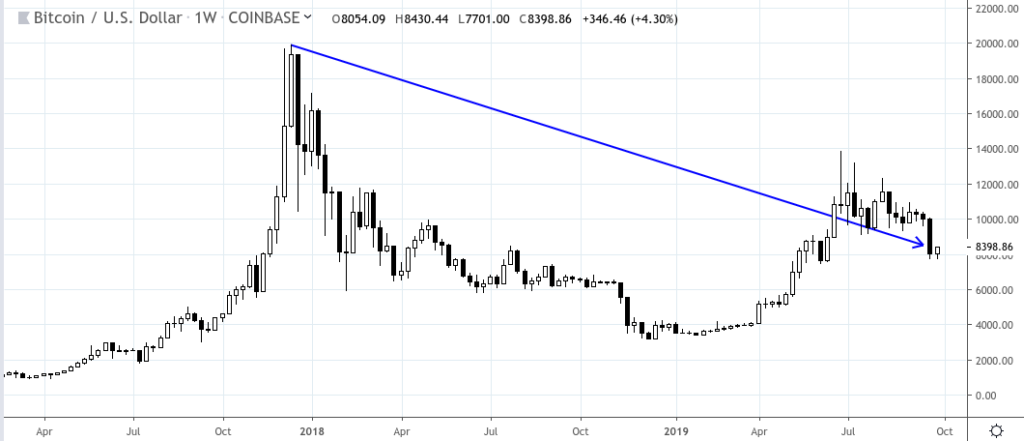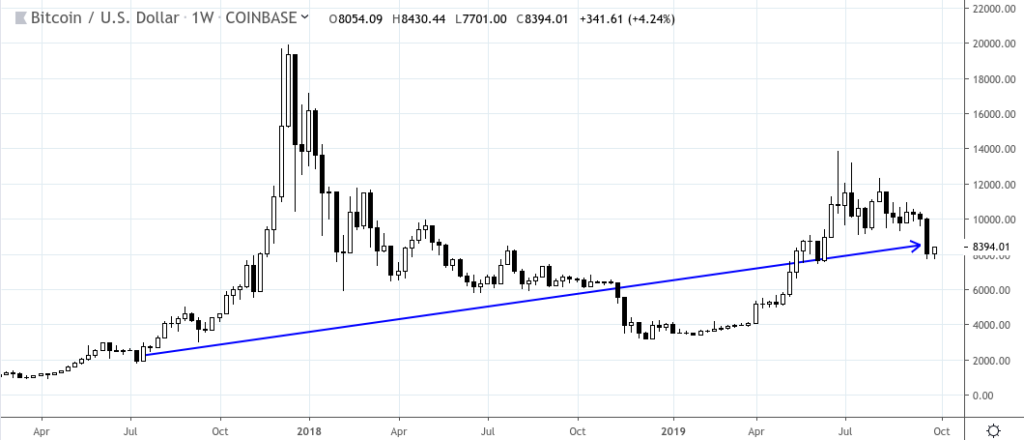If you walked into a grocery store or a coffee shop in December of 2017, you likely overheard several people talking about numerous cryptocurrencies, sounding almost as if they were crypto-experts. Everyone seemed to have a crypto recommendation.
It was that moment–when an investment became a fashionable conversation topic—when one might have predicted that we were in the midst of a massive cryptocurrency bubble. Great investment ideas are rarely fashionable.
Was Bitcoin a Bad Investment?
There are two ways to look at Bitcoin from the 2018 crash up until now. Here’s the first:
BTC/USD – Weekly Chart – February 2017 to September 2019

And here’s the second:
BTC/USD – Weekly Chart – February 2017 to September 2019

The first image shows you what many naysayers have been bellowing during BTC’s entire rise: it’s a repeat of 17th century Tulip Mania. Tulip mania is believed to be the first recorded speculative bubble – it was a period in 17th century Dutch history where the price of tulips reached record high prices and then prices collapsed shortly after.
The second image doesn’t necessarily disagree with the criticism of the first (it is the same chart), but it shows you that “tulips” do have some kind of fundamental value, whether it undergoes a bubble or not. In other words, they cost something at the store.
Bitcoin too has monetary value however speculative that value may be (we’re talking about the coin and not its underlying blockchain technology).
What Drove the Bubble?
As with every investment, Bitcoin price is driven by (perceived) fundamentals and investor sentiment. The fundamentals–e.g. coin limit–depend on adoption, and that’s where speculation comes in, as Bitcoin isn’t anywhere near replacing money.
HODLR’s (long-term “holders” in crypto-speak) invest in crypto likely from a space driven by ideology or long-term speculation. They are betting that Bitcoin “might” be a safe-haven alternative to the dollar, perhaps one that can compete with silver and gold.
Short-term traders were likely the ones who were burned the most during the crash. Many got in to make a fortune, only to lose a fortune by the time they got out. Perhaps some were able to go short Bitcoin and come out ahead. But why take that kind of a risk when there are plenty of other commodity futures contracts that had adequate liquidity and real. time tested fundamentals?
Managing Risk in a Highly-Uncertain Trading Environment
It doesn’t matter if it was Bitcoin, Ethereum, or Ripple; or whether it is an IPO or illiquid commodities like lumber, dairy, or cotton–you might not want to “bet the farm” in these types of markets, or any single market for that matter.
If you had kept your speculative allocation in Bitcoin to a reasonable minimum, depending on when you bought it, you may be up a lot, or breakeven, or maybe you would have sustained a small loss. In the meantime, if you were smart enough to keep your risks to a minimum, you might even have diversified your portfolio to capture the major bull trend in equities.
If you “traded” Bitcoin, you might have made a decent return or a whopping loss. It depends on how much money you allocated toward your Bitcoin trade and when you entered and exited the market. The same can be said if you mismanaged your funds in trading futures or currencies.
The Bottom Line
If you are considering trading any virtual currency products, such as Bitcoin, you should be aware that NFA does not have regulatory oversight authority over underlying or spot virtual currency products or transactions or virtual currency exchanges, custodians or markets.
Notice from CFTC: Customer Advisory: Understand the Risks of Virtual Currency Trading
Notice from NFA: NFA Investor Advisory—Futures on Virtual Currencies Including Bitcoin
It’s not so much “what” you trade but “how” you trade it that counts. Bitcoin was (and perhaps still is) a high-risk and high-return prospect, as are other markets like derivatives, IPOs, and other emerging assets, markets, sectors, or industries.
Remember to keep high risk positions to a minimum relative to the size of your overall portfolio.
Please be aware that the content of this blog is based upon the opinions and research of GFF Brokers and its staff and should not be treated as trade recommendations. There is a substantial risk of loss in trading futures, options and forex. Past performance is not necessarily indicative of future results.
GFF BROKERS IS A MEMBER OF NFA AND IS SUBJECT TO NFA’S REGULATORY OVERSIGHT AND EXAMINATIONS. HOWEVER, YOU SHOULD BE AWARE THAT NFA DOES NOT HAVE REGULATORY OVERSIGHT AUTHORITY OVER UNDERLYING OR SPOT VIRTUAL CURRENCY PRODUCTS OR TRANSACTIONS OR VIRTUAL CURRENCY EXCHANGES, CUSTODIANS OR MARKETS.
Disclaimer Regarding Hypothetical Performance Results: HYPOTHETICAL PERFORMANCE RESULTS HAVE MANY INHERENT LIMITATIONS, SOME OF WHICH ARE DESCRIBED BELOW. NO REPRESENTATION IS BEING MADE THAT ANY ACCOUNT WILL OR IS LIKELY TO ACHIEVE PROFITS OR LOSSES SIMILAR TO THOSE SHOWN. IN FACT, THERE ARE FREQUENTLY SHARP DIFFERENCES BETWEEN HYPOTHETICAL PERFORMANCE RESULTS AND THE ACTUAL RESULTS SUBSEQUENTLY ACHIEVED BY ANY PARTICULAR TRADING PROGRAM.
ONE OF THE LIMITATIONS OF HYPOTHETICAL PERFORMANCE RESULTS IS THAT THEY ARE GENERALLY PREPARED WITH THE BENEFIT OF HINDSIGHT. IN ADDITION, HYPOTHETICAL TRADING DOES NOT INVOLVE FINANCIAL RISK, AND NO HYPOTHETICAL TRADING RECORD CAN COMPLETELY ACCOUNT FOR THE IMPACT OF FINANCIAL RISK IN ACTUAL TRADING. FOR EXAMPLE, THE ABILITY TO WITHSTAND LOSSES OR TO ADHERE TO A PARTICULAR TRADING PROGRAM IN SPITE OF TRADING LOSSES ARE MATERIAL POINTS WHICH CAN ALSO ADVERSELY AFFECT ACTUAL TRADING RESULTS. THERE ARE NUMEROUS OTHER FACTORS RELATED TO THE MARKETS IN GENERAL OR TO THE IMPLEMENTATION OF ANY SPECIFIC TRADING PROGRAM WHICH CANNOT BE FULLY ACCOUNTED FOR IN THE PREPARATION OF HYPOTHETICAL PERFORMANCE RESULTS AND ALL OF WHICH CAN ADVERSELY AFFECT ACTUAL TRADING RESULTS.